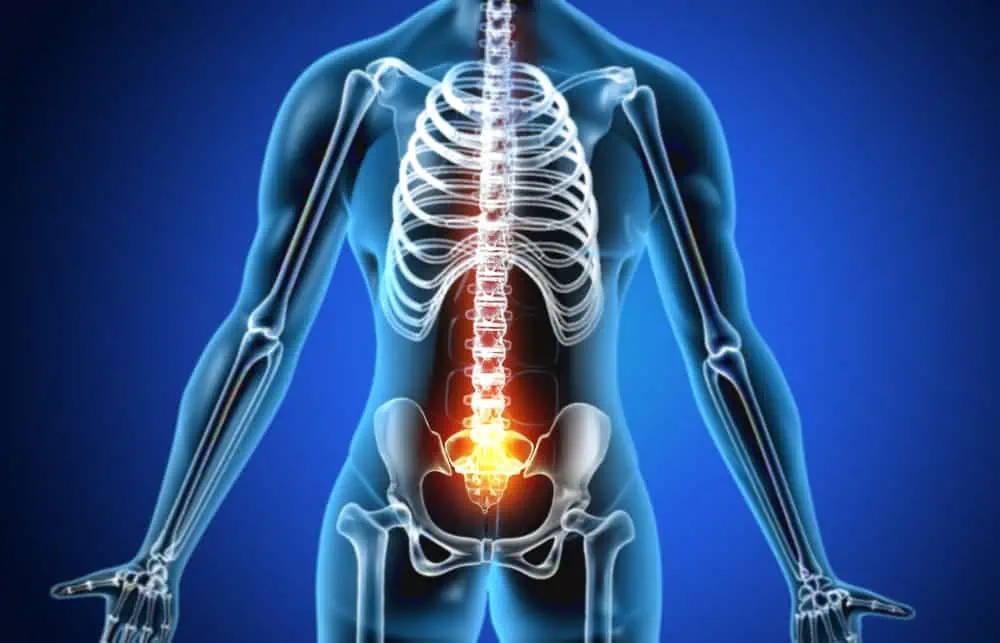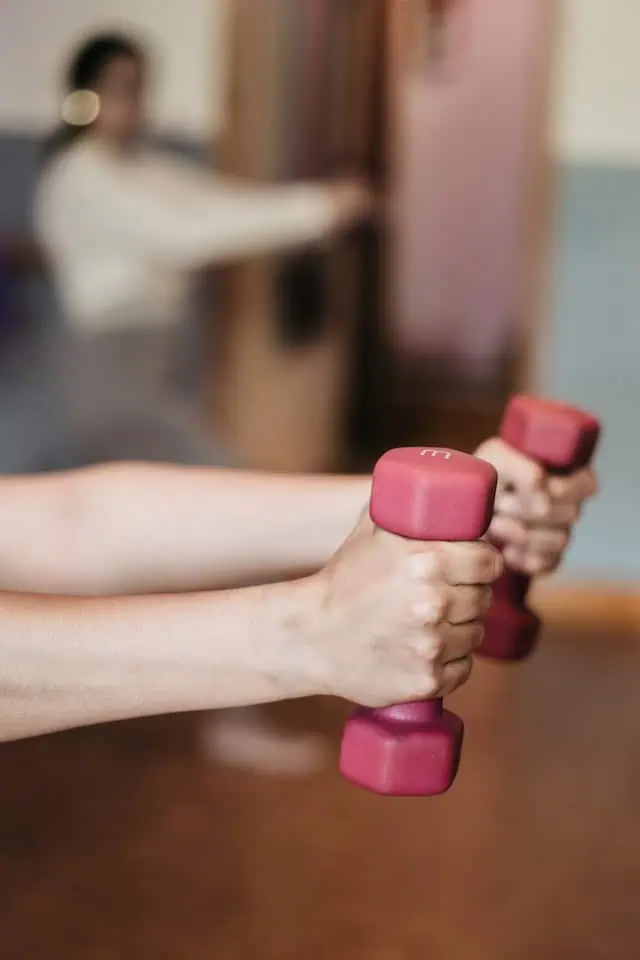When experiencing sacroiliac (SI) joint pain, it’s crucial to identify exercises that can help alleviate discomfort and those that may exacerbate the condition. The SI joint is a critical junction where the spine meets the pelvis, and it plays a significant role in transferring weight and movement between the upper and lower body. However, this joint can become a source of pain due to various reasons, including injury, arthritis, or pregnancy.
Engaging in appropriate physical activity is essential for managing SI joint pain and to reduce SI joint pain. Not all exercises are beneficial for this condition. Some forms of exercise may apply undue stress on the SI joint, potentially leading to increased pain and discomfort. Therefore, it’s important to recognize which movements to avoid to prevent aggravating the joint. Our understanding of the SI joint’s function and the complexities of its pain patterns allows us to recommend safe management strategies while steering clear of harmful activities.

Key Takeaways
- Engage in SI joint-friendly exercises to manage pain effectively.
- Avoid exercises that place excessive stress on the SI joint.
- Consult professionals for tailored advice and long-term relief strategies.
Understanding Sacroiliac Joint Pain
When addressing sacroiliac joint pain, it’s essential to consider the joint’s structure, common causes of discomfort, symptoms for diagnosis, and the impact of exercise and lifestyle factors. Our discussion aims to clarify these aspects and their interconnections.
Anatomy of the Sacroiliac Joint
The sacroiliac joint, or SI joint, is a critical point where the sacrum at the base of the spine meets the ilium bones of the pelvis. This joint is supported by strong ligaments and is designed to bear the body’s weight and transfer it between the upper body and the hips. While it does not have extensive movement, its stability is crucial for effective mobility.
Causes of Discomfort
Discomfort in the SI joint can arise from various sources, including injury from impacts such as falls, trauma, or during sports activities. Arthritis, an inflammation of the joints which can include osteoarthritis, may develop within the joint, causing pain. Pregnancy often leads to hormonal changes, especially an increase in the hormone relaxing, which loosens ligaments and can lead to hypermobility and instability within the SI joint.
Symptoms and Diagnosis
Symptoms often manifest as lower back pain or pelvic pain, which may be indicative of SI joint dysfunction. Accurate diagnosis generally requires a doctor’s assessment, which may include physical exams and imaging tests. SI joint pain can be mistaken for other medical conditions, making professional diagnosis key.
The Role of Exercise and Movement
Exercise and movement play dual roles in the health of the SI joint. On one hand, regular exercises targeting the core muscles around the pelvis can boost stability and prevent pain. However, certain high-impact or repetitive activities might exacerbate discomfort and should be approached with caution. Physical therapy and stretching can enhance joint function and alleviate SI joint pain.
Impact of Lifestyle and Hormonal Factors
Lifestyle choices can influence SI joint health. Maintaining a healthy weight reduces stress on the joint, while poor posture or inadequate footwear might have detrimental effects. Hormonal changes during pregnancy or other life phases can also affect ligament laxity and joint stability. Modifying activities to avoid undue stress on the SI joint is often recommended.
Effective Management Strategies
When managing sacroiliac (SI) joint pain, it is crucial to engage in activities that do not exacerbate symptoms. We’ll guide you through exercise precautions, tailor-made exercises, and ways to adapt daily activities to manage pain effectively.
Exercise Precautions
In addressing SI joint pain, safety is paramount. We must avoid high-impact activities and traditional cardio machines that may aggravate the SI joint. Contact sports and climbing stairs are also activities to avoid as they can lead to further injury and inflammation.
Recommended Exercises
Focusing on low-impact stretching and strengthening exercises will help stabilize and alleviate the stress on the SI joint. For example, when performing the knee-to-chest stretch, ensure your feet are flat on the floor to maintain proper alignment. A targeted approach includes exercises such as the knee-to-chest stretch and the clamshell to promote muscle balance and joint function while avoiding excess strain.
Physical Therapy and Rehabilitation
Under the guidance of a physical therapist, tailor-made rehabilitation programs for SI joint dysfunction promote recovery and prevent further injury. In the Bird Dog exercise, extend your left arm forward while simultaneously extending your right leg behind you to work on lower back and abdominal muscles. The bird dog is an excellent exercise to foster core muscle stabilization, a vital component of SI joint rehabilitation.
Adapting Activities for Pain Avoidance
We should adjust our daily activities to accommodate the SI joint. For instance, maintaining neutral pelvic alignment while performing everyday tasks can lessen pain triggers. It’s also helpful to alternate between sitting and standing to keep the joint from becoming stiff.
Home Care and Self-Help Techniques
In the comfort of our own home, applying cold and hot packs effectively reduces inflammation and promotes relaxation. Engaging regularly in gentle activities such as stretching, yoga, or pilates can strengthen our core and improve the SI joint’s function and overall balance, providing SI joint pain relief.
When managing sacroiliac (SI) joint pain, it’s crucial to recognize the exercises that could aggravate your condition. Certain types of movements can increase the stress on your SI joints, leading to heightened pain and discomfort. Here, we outline specific exercises to sidestep to help protect your SI joints from further strain.
Exercises to Avoid
When managing sacroiliac (SI) joint pain, it’s crucial to recognize the exercises that could aggravate your condition. Certain types of movements can increase the stress on your SI joints, leading to heightened pain and discomfort. Here, we outline specific exercises to sidestep to help protect your SI joints from further strain.

High-Impact Activities
Running: The repetitive impact of running can jar the SI joints, resulting in exacerbated pain for those with SI joint dysfunction. Similarly, contact sports, which often involve jostling and jarring motions, are likely to worsen SI joint pain.
Activities to Avoid:
- Running
- Contact sports like football, rugby, or basketball
- High-impact aerobics
Intense Stretches and Strength Exercises
Certain stretches and strength exercises can place undue stress on the SI joints. For example, avoid deep lunges or step-ups that require keeping your knees bent for extended periods, as this can place undue stress on the SI joint. A deep hamstring stretch can tug on the pelvis and aggravate the SI joint. Likewise, exercises that involve intense or deep twisting—such as when playing tennis or golf—might prompt SI joint discomfort.
Strength Exercises to Avoid:
- Crunches
- Deep lunges or step-ups
- Bridging
- Clamshells
Some Traditional Fitness Equipment
Traditional cardio machines, such as the treadmill or stair climber, may cause repetitive stress on the SI joints, leading to increased discomfort. When considering gym equipment, it’s essential to choose machines that support the SI joint rather than taxing it.
Equipment to Avoid:
- Treadmills
- Stair climbers
- Leg presses that require forceful extension or rotation
Movements Provoking Hyperextension or Rotation
Exercises that induce hyperextension or significant rotation of the pelvis can strain the SI joints. When performing exercises, ensure your body maintains a straight line to avoid placing additional stress on the SI joint. For instance, a move like the ball squeeze can create tension in the pelvic area, and intense maneuvers that involve turning or rotational forces are potential triggers for SI joint pain.
Movements to Avoid:
- Any exercise that involves hyperextension of the lower back
- Activities that require forceful twisting or rotational movements
When to Seek Professional Care
When dealing with sacroiliac (SI) joint pain, safety should always be our priority. We must know when to seek professional care to avoid complications such as prolonged injury or worsening symptoms.

Identifying Aggravating Movements
Our first step is to recognize movements that exacerbate our SI pain. Certain activities, especially those that involve twisting or heavy lifting, can increase discomfort in the lower back and buttocks. We should keep a daily log to track which motions lead to increased pain and avoid them as part of our treatment protocol.
Consulting with a Physical Therapist
If simple rest and avoiding pain-inducing movements do not lead to improvement, consulting with a physical therapist can be crucial. They can assess for any muscle imbalances or tight muscles contributing to our pain and recommend specific exercises that focus on strengthening and stabilizing the SI joint without additional risk of injury.
Monitoring Pain and Symptoms
It’s essential for us to closely monitor our pain and symptoms. If we notice that our pain persists or becomes more severe despite our efforts at home, it may be indicative of a need for professional intervention. We must be vigilant for signs like:
- Pain that radiates or increases
- A feeling of instability in the pelvis
- Difficulty performing daily tasks
Exploring Medical Interventions
Sometimes, despite our best efforts, pain management may require medical interventions. In such cases, we should consult with a doctor who might suggest treatments such as corticosteroid injections or physical therapy. It’s vital that we explore these options to ensure we are taking comprehensive care of our health and not risking further injury.
Lifestyle Modifications for Long-Term Relief
To effectively manage sacroiliac joint pain, we must integrate comprehensive lifestyle modifications. These adjustments complement exercises by targeting factors that contribute to overall joint health and pain reduction.

Nutrition and Body Weight Management
A balanced diet rich in anti-inflammatory foods can substantially alleviate sacroiliac joint pain. We should incorporate foods high in omega-3 fatty acids, such as salmon and flaxseeds, and plenty of leafy greens. Managing body weight is essential because excess weight can increase stress on the SI joint. Maintaining a healthy weight not only reduces this stress but also improves general well-being.
Stress Reduction and Relaxation Techniques
Chronic stress can heighten our perception of pain, making it crucial to practice effective stress management. We can adopt relaxation techniques such as deep breathing exercises, meditation, or yoga. These practices promote relaxation and have been shown to reduce muscle tension and augment our pain management strategy.
Improving Core Strength and Stability
Enhancing the strength and stability of our core muscles supports the sacroiliac joint and alleviates excessive strain. We should focus on exercises like modified planks and bridges that strengthen without overstretching the SI joint. Strengthening our core is critical to provide better support for our lower back and reduce the risk of pain flare-ups.
Posture and Ergonomics
To minimize SI joint stress, we must pay attention to our posture throughout the day. Correct posture reduces pressure on the SI joint, while poor ergonomic practices can exacerbate pain. Ergonomic interventions include using chairs with proper lumbar support and standing desks. Good practices will promote good posture and contribute significantly to long-term pain relief.

Conclusion
When managing sacroiliac joint pain, it’s crucial for us to be mindful of the exercises we choose. Intensity, technique, and frequency are significant factors that can influence our treatment outcomes.
- Avoid: High-impact exercises
- Emphasize: Low-impact, controlled movements
Strength building and flexibility are pivotal, yet we must proceed cautiously. Our exercise regimen should include movements that are gentle on the sacroiliac joint, promoting healing rather than exacerbating pain.
Exercises to consider:
- Pelvic tilts
- Partial crunches
Proper alignment is as important as the exercises themselves. We aim to maintain a neutral spine to alleviate undue stress on the sacroiliac joints.
It is wise for us to consult healthcare professionals who can provide tailored advice based on individual conditions. As knowledgeable advocates for our health, we should stay informed and involved in our treatment plans, ensuring we engage in the most beneficial practices for our sacroiliac joint health.
Frequently Asked Questions
In this section, we’ll address common concerns about activities and exercises that might aggravate sacroiliac (SI) joint pain.
Which exercises should be avoided with sacroiliac joint pain?
We should avoid high-impact activities, such as running or plyometric exercises, as these can increase stress on the SI joint.
What activities exacerbate sacroiliac joint discomfort?
Activities that involve uneven loading of the pelvis, like lunging with heavy weights or step aerobics, can worsen SI joint discomfort.
Are there any stretches that might worsen SI joint pain?
We should be cautious with deep twisting stretches or any movement that puts the SI joint in a vulnerable position.
What movements should I steer clear of to prevent aggravating my SI joint pain?
It’s best to steer clear of heavy lifting that involves a lot of bending or twisting motions, which can place extra stress on the SI joint.
Can certain exercises increase inflammation in the sacroiliac joint?
Yes, repetitive or jarring movements often found in high-impact sports can increase inflammation in the SI joint.
How can I modify my workout to prevent triggering sacroiliac joint pain?
We can modify our workouts by focusing on low-impact exercises and ensuring proper alignment to prevent triggering sacroiliac joint pain.














